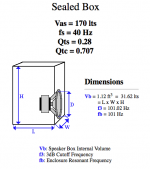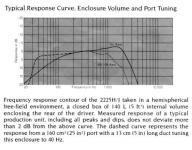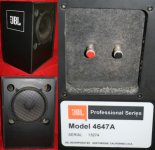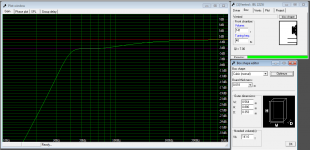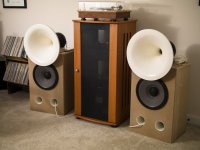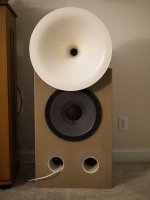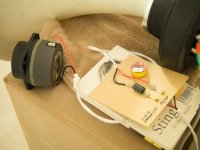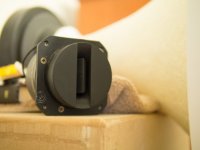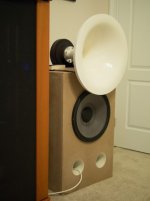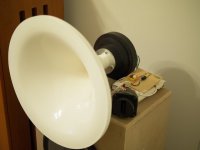Hi folks -- I am starting a new project and could use some guidance and help. I just acquired the following JBL pro components and am thinking that I want to build and OB/compression driver system around this.
Just for reference:
* My main source is vinyl; Sony TTS 3000a turntable with VLPS II phono preamp and a Decware CSP2 preamp.
* I have a pair of SET mono block 300b amps to run my wide-range (likely the compression drivers and super tweeters.
* I have a Rotel 1050b SS amplifier to run the LF drivers.
* I have a MiniDSP at my disposal as well.
The components I picked up are:
* Pair of JBL 2225j 15" LF Drivers.
* Pair of 2445J 2" compression drivers
* Pair of JBL 2405 super tweeters.
* Dividing unit for the 2225J/2445J (12 dB/octave 800 Hz x-over).
* 12 dB/octave passive x-over for the super tweeter. I think 8k or so.
* 150 Hz expo horns for the 2" drivers. (Similar to what is shown here).
So I am at the point where I want to design a really nice system. But don't quite know the best way forward. Currently I have a pair of Eminence Alpha 15a speakers in H-Frames and a Mark Audio alpair 10.3 on an open baffle. I also have been using a pair of Kef C55s coupled with H-frames. I mainly listen to Jazz and classic rock.
I could certainly build a ported box for the 15s, as is spec'd in the JBL lit. But I am also contemplating doing a open baffle design similar to what is seen here.
Basically, he is using a Alpha 15 in OB, along with a 8" mid OB and the 2" compression/super tweeter setup. With the MiniDSP, matching efficiency of the horns and the transducers won't be a problem. Just want some ideas here.
The other idea is the run the JBL in OB for mid (100Hz-700Hz) and have the other 15" for < 100Hz in the H-frame. I could still use the JBL dividing network and couple that with the MiniDSP for bi-amping (LR 4 @ 100 Hz, rolling off the LF to the other 15).
Looking forward to some opinions. Thanks!
Just for reference:
* My main source is vinyl; Sony TTS 3000a turntable with VLPS II phono preamp and a Decware CSP2 preamp.
* I have a pair of SET mono block 300b amps to run my wide-range (likely the compression drivers and super tweeters.
* I have a Rotel 1050b SS amplifier to run the LF drivers.
* I have a MiniDSP at my disposal as well.
The components I picked up are:
* Pair of JBL 2225j 15" LF Drivers.
* Pair of 2445J 2" compression drivers
* Pair of JBL 2405 super tweeters.
* Dividing unit for the 2225J/2445J (12 dB/octave 800 Hz x-over).
* 12 dB/octave passive x-over for the super tweeter. I think 8k or so.
* 150 Hz expo horns for the 2" drivers. (Similar to what is shown here).
So I am at the point where I want to design a really nice system. But don't quite know the best way forward. Currently I have a pair of Eminence Alpha 15a speakers in H-Frames and a Mark Audio alpair 10.3 on an open baffle. I also have been using a pair of Kef C55s coupled with H-frames. I mainly listen to Jazz and classic rock.
I could certainly build a ported box for the 15s, as is spec'd in the JBL lit. But I am also contemplating doing a open baffle design similar to what is seen here.
Basically, he is using a Alpha 15 in OB, along with a 8" mid OB and the 2" compression/super tweeter setup. With the MiniDSP, matching efficiency of the horns and the transducers won't be a problem. Just want some ideas here.
The other idea is the run the JBL in OB for mid (100Hz-700Hz) and have the other 15" for < 100Hz in the H-frame. I could still use the JBL dividing network and couple that with the MiniDSP for bi-amping (LR 4 @ 100 Hz, rolling off the LF to the other 15).
Looking forward to some opinions. Thanks!
That is certainly what I would do also (two boxes for stereo), given the components you have to work with.I could certainly build a ported box for the 15s, as is spec'd in the JBL lit.
The stock JBL passive crossovers are not likely to be ideal for the different horn choice.
Last edited:
That is certainly what I would do also, given the components you have to work with.
Thank you for the response. Do you think that running the 15" in a 5 cu ft box tuned to 40 Hz from 40 Hz - 800 Hz is going to be a good way to build these out?
Could do an older 801-style cabinet with a front port and the midrange horn and tweeter on top. Would that be reasonable?
Something like this cabinet design?
I think you'd be poisoning the system with the Alpha15. The JBL 2225 is probably about the cleanest woofer you can buy. The Alpha 15 is actually pretty bad but is famous to people that mount them free air because they are way under damped - If it were me and I didn't have the space for a bass horn I'd put the JBL in a sealed box use them as midbass and build some 18" JBL 224* subs to go with the rest of the stuff. Or just use a vented box with the 2225 but it probably will lack bottom end impact on it's own. Remember you are trying to make a coherent system that will "keep up" with the large format compression driver. The best way to do that is build some bass horns. With that big of a midhorn even a folded horn will work because you should be able to cross over around 500 Hz.
I'd prefer tuning a bit lower, like 35 Hz.Thank you for the response. Do you think that running the 15" in a 5 cu ft box tuned to 40 Hz from 40 Hz - 800 Hz is going to be a good way to build these out?
Could do an older 801-style cabinet with a front port and the midrange horn and tweeter on top. Would that be reasonable?
Something like this cabinet design?
Box shape looks reasonable, I prefer rounded corners rather than 45 degree angles.
Ok, fair enough. As I said, the Alpha 15 in H-frame is something that I had been using, before I picked up this JBL gear.I think you'd be poisoning the system with the Alpha15. The JBL 2225 is probably about the cleanest woofer you can buy. The Alpha 15 is actually pretty bad but is famous to people that mount them free air because they are way under damped
Bass horn sound very interesting, but I think I would have a challenge getting them in my room, but depending on the design it may work. What bass horn design would you suggest? My woodworking skills are pretty decent, but I currently lack many of the tool that I would likely need to build this right -- I am currently limited to a table saw with straight cut guide (works quite well), router and jasper jig, roto-zip and other basic tools (clamps, drill, impact driver, nail gun etc.)- If it were me and I didn't have the space for a bass horn I'd put the JBL in a sealed box use them as midbass and build some 18" JBL 224* subs to go with the rest of the stuff.
I might be able to bribe a friend to loan me his table saw or even help me build them, depending on the complexity of the design. In the short term, though, getting the system set up in a sealed box for a mid bass might make the most sense. I will have to run the number on the sealed box and see what it looks like. In a pinch, and for the time being, I could always have the Alpha 15s help out while I develop something else to fill in the lowest two octaves.
Good to know. Thank you for the detail response, that gives me a lot to think about. It's very helpful to talk this stuff through, before going out and spending a lot of money and time on materials.Or just use a vented box with the 2225 but it probably will lack bottom end impact on it's own. Remember you are trying to make a coherent system that will "keep up" with the large format compression driver. The best way to do that is build some bass horns. With that big of a midhorn even a folded horn will work because you should be able to cross over around 500 Hz.
A straight midbass horn with no folds is ideal because it offers the cleanest upper range response. Their are many different flare types available to build and some can be difficult to do. This fellow built a pair of nice conical 77 hz flare horns for an EV 15" driver and the plans show it can be built without a lot of worry. http://www.volvotreter.de/downloads/Conical_77Hz_Midbass_1.0.pdf
If you want to model your own horn there is an excellent free program out there called HornResponse - it allows you to use the woofers you have and configure just about any horn for it with instant graphics. It works great compared to reality. The high frequency response is normally better then the CD response in the program. The JBL 2225 in a good horn (I use them 🙂 is excellent out to around 650 Hz and is usable to around 900.
http://www.diyaudio.com/forums/subwoofers/119854-hornresp.html
Once you've had a bass horn it's difficult to go back to open baffle or a box. The sound is much faster and alive with great impact.
If you want to model your own horn there is an excellent free program out there called HornResponse - it allows you to use the woofers you have and configure just about any horn for it with instant graphics. It works great compared to reality. The high frequency response is normally better then the CD response in the program. The JBL 2225 in a good horn (I use them 🙂 is excellent out to around 650 Hz and is usable to around 900.
http://www.diyaudio.com/forums/subwoofers/119854-hornresp.html
Once you've had a bass horn it's difficult to go back to open baffle or a box. The sound is much faster and alive with great impact.
Quick design of a mid bass enclosure for the 15". The woofer takes up .2 cu ft, so a total of 1.32 cu ft gives me a f3 of 101 Hz. So yes, would need something to supplement this from 100 Hz down. But that would be a compact way to run the 15" as a mid bass from 100 Hz - 800 Hz or so.
My future goal would be to triamp this using a DBX drive rack pa, as is being done here here. This gentleman is running a Eton 11-581 for the bass. That looks like a nice driver, I believe it is also used by Avalon.
"Edgar Horn Mk II Loudspeaker
This Edgar Horn speaker system works very well too. A more compact version using an 80L Bass reflex box which models on WIN-ISD as being capable of going down to about 27 Hz +/- 3dB using the Eton 11-581 bass driver. Most of the good sound of the bigger 190L system shown above is retained, but Mk II is half the size."
ETA: writing this as you responded, @POOH. Thanks for the link to the mid bass horn. It's huge!! And I know that is a pretty small horn. Looks reasonable to build, though. I would still need a subwoofer with this, correct? I know this will be a journey, not a race.
My future goal would be to triamp this using a DBX drive rack pa, as is being done here here. This gentleman is running a Eton 11-581 for the bass. That looks like a nice driver, I believe it is also used by Avalon.
"Edgar Horn Mk II Loudspeaker
This Edgar Horn speaker system works very well too. A more compact version using an 80L Bass reflex box which models on WIN-ISD as being capable of going down to about 27 Hz +/- 3dB using the Eton 11-581 bass driver. Most of the good sound of the bigger 190L system shown above is retained, but Mk II is half the size."
ETA: writing this as you responded, @POOH. Thanks for the link to the mid bass horn. It's huge!! And I know that is a pretty small horn. Looks reasonable to build, though. I would still need a subwoofer with this, correct? I know this will be a journey, not a race.
Attachments
A pair of 2225 each in a 5 cubic foot box are capable of around 120 dB down to 40 Hz in room.Quick design of a mid bass enclosure for the 15". The woofer takes up .2 cu ft, so a total of 1.32 cu ft gives me a f3 of 101 Hz. So yes, would need something to supplement this from 100 Hz down. But that would be a compact way to run the 15" as a mid bass from 100 Hz - 800 Hz or so.
Your pair of Eminence Alpha 15a speakers in H-Frames are perhaps capable of 100 dB at 40 Hz, probably considerably less.
At 40 Hz, it takes less than a 10 dB increase in level to sound twice as loud, the JBLs are capable of at least four times the LF level of what you currently have.
Since you mostly listen to vinyl, which seldom has much <40 content, and will tend to feed back (howl) at levels approaching 120 dB, additional LF extension is probably not required, but could be added.
That said, unless you like LF level literally equivalent to putting your head in front of a rock kick drum (about 120 dB) adding a sub below your woofers won't be needed.
I was mixing sound in a club last Friday, the DJ's JBL SRX system was hitting about 125 dBC near the stack (two 728 & one 735 per side), there is no way I'd want to listen at that level in a small room anymore, but you may have inclinations more like Pooh than me.
I'd suggest getting a SPL meter and checking the levels you normally listen at before thinking in terms of large mid/bass horn systems, most people concerned with their hearing don't listen above 100 dBA (slow), which happens to be the OSHA permissible level for two hour exposure. Bass levels (dB or dBC) might be 10 dB higher than that for rap or dubstep, but for jazz and classic rock, the spectrum is fairly flat.
Art
Attachments
I have designed and built many bass horns and have used them for PA use, I have no difficulty "going back" to bass reflex (or sealed) designs for home use.Once you've had a bass horn it's difficult to go back to open baffle or a box. The sound is much faster and alive with great impact.
Open baffle bass would not suffice though, don't have enough space (or money) to achieve decent LF level.
Thanks @weltersys. Sheer volume is not what I am looking for, but rather balance, headroom and bass impact. I do not often listen louder than 90 dB(C) and certainly not louder than 100 dB(C). I think you are correct about the Alpha 15s, they will not do 100 dB @ 40 Hz. It's closer to 90-93 dB without sounding very strained.
I suppose this is the box design I want to start to build:
"The JBL 4647A low frequency system is designed for general sound reinforcement, smaller motion picture theaters, and as an individual module in cluster design. Power response is smooth, and axial response extends to 1200 Hz. The system uses the 2226H 380 mm (15 in) patented Vented Gap CoolingTM transducer for high power handling and reduced power compression. The transducer features a 100 mm (4 in) voice coil operating in a large symmetrical field geometry (SFG) magnet structure to reduce a second harmonic distortion to inconsequential levels. The enclosure is constructed of dense stock and is extensively braced on all panels. Net internal volume is 145 1(5 cu ft), and the enclosure is tuned to 40 Hz. Port area is large, ensuring minimum turbulence at full power input at low frequencies."
"High-pass: 40 Hz, 12-dB/octave
Low-pass: 500, 800, or 1200 Hz, 12- or 18-dB/octave
ENCLOSURE SPECIFICATIONS:
Materials and finish: 19 mm (¾ inch) particle board with 25 mm (1 inch) baffle;
matte black finish
Enclosure volume: 145l (5 cu ft)
Vent tuning frequency: 40 Hz
Dimensions H x W x D:
775 mm x 546 mm x 448 mm
(30½ in x 21½ in x 175/8 in)
Net weight: 28.6 kg (63 lb)
Shipping weight: 32.7 kg (72 lb)"
Looks like maybe 4 4" ports? I'd have to figure out how deep.
I suppose this is the box design I want to start to build:
"The JBL 4647A low frequency system is designed for general sound reinforcement, smaller motion picture theaters, and as an individual module in cluster design. Power response is smooth, and axial response extends to 1200 Hz. The system uses the 2226H 380 mm (15 in) patented Vented Gap CoolingTM transducer for high power handling and reduced power compression. The transducer features a 100 mm (4 in) voice coil operating in a large symmetrical field geometry (SFG) magnet structure to reduce a second harmonic distortion to inconsequential levels. The enclosure is constructed of dense stock and is extensively braced on all panels. Net internal volume is 145 1(5 cu ft), and the enclosure is tuned to 40 Hz. Port area is large, ensuring minimum turbulence at full power input at low frequencies."
"High-pass: 40 Hz, 12-dB/octave
Low-pass: 500, 800, or 1200 Hz, 12- or 18-dB/octave
ENCLOSURE SPECIFICATIONS:
Materials and finish: 19 mm (¾ inch) particle board with 25 mm (1 inch) baffle;
matte black finish
Enclosure volume: 145l (5 cu ft)
Vent tuning frequency: 40 Hz
Dimensions H x W x D:
775 mm x 546 mm x 448 mm
(30½ in x 21½ in x 175/8 in)
Net weight: 28.6 kg (63 lb)
Shipping weight: 32.7 kg (72 lb)"
Looks like maybe 4 4" ports? I'd have to figure out how deep.
Attachments
Please consider you need a pretty wide baffle to keep the efficiency in the bass when you use a box vented or otherwise. The 2225 has a rising on axis response and the horn will compensate forit - the opposite what you'll get using a narrow baffle box.
A midbass horn is all about unrivaled sound quality in the bass and low midrange not MAX SPL. Higher output is a natural byproduct with a horn over the typical vented PA boxes the JBL normally is used in.
The 2226 is a different animal then the 2225.
A midbass horn is all about unrivaled sound quality in the bass and low midrange not MAX SPL. Higher output is a natural byproduct with a horn over the typical vented PA boxes the JBL normally is used in.
The 2226 is a different animal then the 2225.
Last edited:
The 2226 has greater Xmax than the 2225, so needs more port area to keep them from "blowing out".Thanks @weltersys. Sheer volume is not what I am looking for, but rather balance, headroom and bass impact. I do not often listen louder than 90 dB(C) and certainly not louder than 100 dB(C). I think you are correct about the Alpha 15s, they will not do 100 dB @ 40 Hz. It's closer to 90-93 dB without sounding very strained.
I suppose this is the box design I want to start to build:
"The JBL 4647A ...uses the 2226H .
Looks like maybe 4 4" ports? I'd have to figure out how deep.
The single longer port in post #9 would be more appropriate for your application, less midrange wrap around.
If you have been used to only 90 dB at 40 Hz, being able to hit 120 dB at 40 Hz is going to make a HUGE difference in impact. 😉.
Art
This is the 2225J in a 5 cu ft box tuned to 40 Hz. 22" wide, 34" tall, 14" deep is the optimal according to WinISD. I may need a deeper box not as wide to have enough room for the horn.
I can use a single 5.5" round port 3.89" long to tune to 40 Hz.
Does that low midrange drop from 300 Hz down to the tuning frequency bother anybody?
I can use a single 5.5" round port 3.89" long to tune to 40 Hz.
Does that low midrange drop from 300 Hz down to the tuning frequency bother anybody?
Attachments
Your H frames have a drop off like a cliff, does that bother you 😀?Does that low midrange drop from 300 Hz down to the tuning frequency bother anybody?
Your in room response will not be anything like flat, so don't worry about a few dB over several octaves.
You could easily correct that falling response with DSP, or turning up the "bass" knob a hair.
You have a point @weltersys about the h-frames but the goal here is to make a large improvement in my playback system. I could easily add a 3 dB shelving filter to knock down the response from 80 Hz - 800 Hz, to counter that rising response.
Up to my experience and reading, the "secret" for clean, punchy and high-quality bass is to remember what is happening in a small room!
We are fed with the belief that a speaker should have straright anechoid bass response as low as possible. At leas WinISD and other simulations drive people to aim for it, which is wrong! It easily leads to huge peaking in room response at 40-80Hz, right where room modes work too. Many commercial "large" speakers also boost response up to 200Hz, because people want to hear big bass from their big speakers.
Sealed Qts 0.7 or low-tuned BR or a well designed (folded) horn or pipe are "sane" systems usually. Sealed has highest distortion of these because it gets acoustic gain only from the room if we use same driver and same room spl.
For a really good bass I would use 15" drivers with high Xmax and make a LLT bass-reflex arrangement (large low-tuned around 20Hz) Perhaps JBL 2225 could do this sufficiently for home listening, with impedance correction at Fs.
We are fed with the belief that a speaker should have straright anechoid bass response as low as possible. At leas WinISD and other simulations drive people to aim for it, which is wrong! It easily leads to huge peaking in room response at 40-80Hz, right where room modes work too. Many commercial "large" speakers also boost response up to 200Hz, because people want to hear big bass from their big speakers.
Sealed Qts 0.7 or low-tuned BR or a well designed (folded) horn or pipe are "sane" systems usually. Sealed has highest distortion of these because it gets acoustic gain only from the room if we use same driver and same room spl.
For a really good bass I would use 15" drivers with high Xmax and make a LLT bass-reflex arrangement (large low-tuned around 20Hz) Perhaps JBL 2225 could do this sufficiently for home listening, with impedance correction at Fs.
Progress...
Thanks to some vacation time from work I was able to bang out the bass cabinets this past weekend, yesterday and today. I just was so excited to see how everything sounded. I will finish up the cabinets once I get everything built and nailed down system-wise.
Cabinet design went pretty well, construction was a bit challenging. I've not built anything this big before. I've also not worked with MDF much before. But I was happy with the way that the subwoofer builder/boxnotes construction scheme and instructions went. Dealing with the 1.5" baffle and the Jasper jig was a challenge as well.
Note to self, buy a right angle jig for my drill for next time so that all of my driver holes and port guide holes are straight. Lesson learned. Also 4" PVC is a challenge to cut with just a back saw. Built the cabs with just a circular saw, router, nail gun, drill/driver, brad nailer and some clamps. Rest was hand tools. Not perfect, but came out better than I expected. A mitre saw would have been helpful for the braces and whatnot, but I was able to manage with a mitre box.
For some reason, the cab came out a bit smaller than I expected. Only about 4 cu ft after accounting for bracing, ports and the driver. Ports are tuned to about 44 or 45 Hz, depending on if you count the round over in the front. I've not measured the impedance yet to verify the resonance. Wired everything up and made sure everything was working -- it was.
Just did a quick setup on the MiniDSP with a 800 Hz LR4 x-over point. Wow! Dynamics and dynamic range. Unlike anything I've heard before. I have about 20 dB more headroom vs. my previous setup (which is to be expected, given the sensitivity difference in the components).
Pretty heavy in the midrange currently from the 15". I suspect after I line the cab with some fiberglass, that will help. Ended up just shelving it down a bit in the mini DSP. I'll make some more measurements later this week when I have some more time. First impressions is that this system has a lot of potential!
Next on the build list is a bracket to help stabilize the compression drivers, and some way to mount the super tweeters so they clear the midrange horns. Any ideas?
Here are some quick shots:
Thanks to some vacation time from work I was able to bang out the bass cabinets this past weekend, yesterday and today. I just was so excited to see how everything sounded. I will finish up the cabinets once I get everything built and nailed down system-wise.
Cabinet design went pretty well, construction was a bit challenging. I've not built anything this big before. I've also not worked with MDF much before. But I was happy with the way that the subwoofer builder/boxnotes construction scheme and instructions went. Dealing with the 1.5" baffle and the Jasper jig was a challenge as well.
Note to self, buy a right angle jig for my drill for next time so that all of my driver holes and port guide holes are straight. Lesson learned. Also 4" PVC is a challenge to cut with just a back saw. Built the cabs with just a circular saw, router, nail gun, drill/driver, brad nailer and some clamps. Rest was hand tools. Not perfect, but came out better than I expected. A mitre saw would have been helpful for the braces and whatnot, but I was able to manage with a mitre box.
For some reason, the cab came out a bit smaller than I expected. Only about 4 cu ft after accounting for bracing, ports and the driver. Ports are tuned to about 44 or 45 Hz, depending on if you count the round over in the front. I've not measured the impedance yet to verify the resonance. Wired everything up and made sure everything was working -- it was.
Just did a quick setup on the MiniDSP with a 800 Hz LR4 x-over point. Wow! Dynamics and dynamic range. Unlike anything I've heard before. I have about 20 dB more headroom vs. my previous setup (which is to be expected, given the sensitivity difference in the components).
Pretty heavy in the midrange currently from the 15". I suspect after I line the cab with some fiberglass, that will help. Ended up just shelving it down a bit in the mini DSP. I'll make some more measurements later this week when I have some more time. First impressions is that this system has a lot of potential!
Next on the build list is a bracket to help stabilize the compression drivers, and some way to mount the super tweeters so they clear the midrange horns. Any ideas?
Here are some quick shots:
Attachments
I am currently building a three way that looks like this:
tweeter : JBL 2408H-1 on a Pyle horn
midrange : dual Dayton ND91s on the same horn. (A Synergy Horn.)
woofer : Diyma R12 (a car audio driver that's somewhat similar to an Eminence Lab sub.)
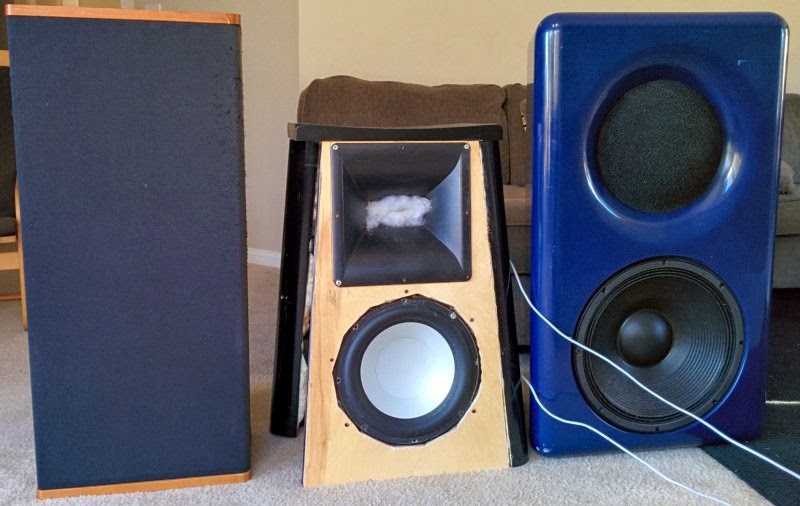
(It's the one in the center.)
Everything but the tweeter is dipole, and I'm using MiniDSP, so it might be worth a look. (The thread is titled "monster massive".)
How are you doing your measurements?
tweeter : JBL 2408H-1 on a Pyle horn
midrange : dual Dayton ND91s on the same horn. (A Synergy Horn.)
woofer : Diyma R12 (a car audio driver that's somewhat similar to an Eminence Lab sub.)

(It's the one in the center.)
Everything but the tweeter is dipole, and I'm using MiniDSP, so it might be worth a look. (The thread is titled "monster massive".)
How are you doing your measurements?
Thanks for the info on the thread @Patrick Bateman. I will check it out. Currently I am doing in-room average measurements while it is too cold to do outdoor gated measurements. I just do a 8 IR average around my listening position to get a good sense of what the speakers are doing in-room. For time-alignment, I was using a 1m measurement with a loop-back to find the peak.
Here is the latest set:
Did some more measurements this week and also tried to time-align the drivers. I did this by setting up a loop-back in REW and then measuring the individual drivers 1m from the box and looking for the peak in time without any delay. I did this with the crossover engaged in MiniDSP to account for the phase shift induced by the crossover. Woofer peak was 3.58 ms, tweeter 3.808 ms, delay set 0.3 on woofer to align.
2226:
80Hz 6 dB/oct LP
40Hz 12 dB/octave HP
0.3ms delay on woofer (matched IR peaks 1m from center of woofer/CD).
2445:
1000Hz 24 dB/oct HP
EQ:
2226:
60 Hz +4 dB Q2 Peak
160 Hz -6 dB to -8dB Q1 Peak
2445:
6000 Hz +8 dB High-Shelf.
In-room response from 8 position measurement per trace around listening position.
I still do not like the dip at the crossover frequency, I thought that would go away with the time alignment. I am also not taking into account the eventual contribution of the 2405s once I get them setup. That should extend my UHF response well past 20k.
Here is the latest set:
Did some more measurements this week and also tried to time-align the drivers. I did this by setting up a loop-back in REW and then measuring the individual drivers 1m from the box and looking for the peak in time without any delay. I did this with the crossover engaged in MiniDSP to account for the phase shift induced by the crossover. Woofer peak was 3.58 ms, tweeter 3.808 ms, delay set 0.3 on woofer to align.
2226:
80Hz 6 dB/oct LP
40Hz 12 dB/octave HP
0.3ms delay on woofer (matched IR peaks 1m from center of woofer/CD).
2445:
1000Hz 24 dB/oct HP
EQ:
2226:
60 Hz +4 dB Q2 Peak
160 Hz -6 dB to -8dB Q1 Peak
2445:
6000 Hz +8 dB High-Shelf.
In-room response from 8 position measurement per trace around listening position.
I still do not like the dip at the crossover frequency, I thought that would go away with the time alignment. I am also not taking into account the eventual contribution of the 2405s once I get them setup. That should extend my UHF response well past 20k.
Attachments
- Status
- Not open for further replies.
- Home
- Loudspeakers
- Multi-Way
- Open Baffle and JBL compression drivers design help
